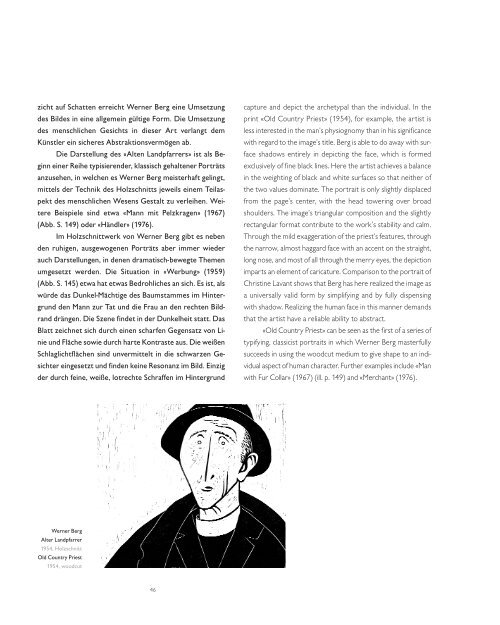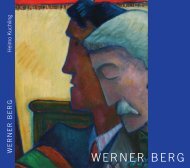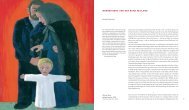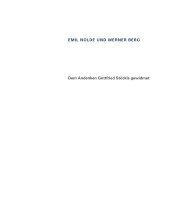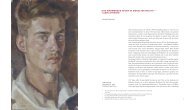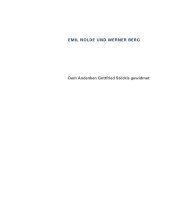Werner Berg Museum
Werner Berg Museum
Werner Berg Museum
- TAGS
- werner
- berg
- wernerberg.museum
Sie wollen auch ein ePaper? Erhöhen Sie die Reichweite Ihrer Titel.
YUMPU macht aus Druck-PDFs automatisch weboptimierte ePaper, die Google liebt.
zicht auf Schatten erreicht <strong>Werner</strong> <strong>Berg</strong> eine Umsetzung<br />
des Bildes in eine allgemein gültige Form. Die Umsetzung<br />
des menschlichen Gesichts in dieser Art verlangt dem<br />
Künstler ein sicheres Abstraktionsvermögen ab.<br />
Die Darstellung des «Alten Landpfarrers» ist als Beginn<br />
einer Reihe typisierender, klassisch gehaltener Porträts<br />
anzusehen, in welchen es <strong>Werner</strong> <strong>Berg</strong> meisterhaft gelingt,<br />
mittels der Technik des Holzschnitts jeweils einem Teilaspekt<br />
des menschlichen Wesens Gestalt zu verleihen. Weitere<br />
Beispiele sind etwa «Mann mit Pelzkragen» (1967)<br />
(Abb. S. 149) oder «Händler» (1976).<br />
Im Holzschnittwerk von <strong>Werner</strong> <strong>Berg</strong> gibt es neben<br />
den ruhigen, ausgewogenen Porträts aber immer wieder<br />
auch Darstellungen, in denen dramatisch-bewegte Themen<br />
umgesetzt werden. Die Situation in «Werbung» (1959)<br />
(Abb. S. 145) etwa hat etwas Bedrohliches an sich. Es ist, als<br />
würde das Dunkel-Mächtige des Baumstammes im Hintergrund<br />
den Mann zur Tat und die Frau an den rechten Bildrand<br />
drängen. Die Szene findet in der Dunkelheit statt. Das<br />
Blatt zeichnet sich durch einen scharfen Gegensatz von Linie<br />
und Fläche sowie durch harte Kontraste aus. Die weißen<br />
Schlaglichtflächen sind unvermittelt in die schwarzen Gesichter<br />
eingesetzt und finden keine Resonanz im Bild. Einzig<br />
der durch feine, weiße, lotrechte Schraffen im Hintergrund<br />
<strong>Werner</strong> <strong>Berg</strong><br />
Alter Landpfarrer<br />
1954, Holzschnitt<br />
Old Country Priest<br />
1954, woodcut<br />
46<br />
capture and depict the archetypal than the individual. In the<br />
print «Old Country Priest» (1954), for example, the artist is<br />
less interested in the man’s physiognomy than in his significance<br />
with regard to the image’s title. <strong>Berg</strong> is able to do away with surface<br />
shadows entirely in depicting the face, which is formed<br />
exclusively of fine black lines. Here the artist achieves a balance<br />
in the weighting of black and white surfaces so that neither of<br />
the two values dominate. The portrait is only slightly displaced<br />
from the page’s center, with the head towering over broad<br />
shoulders. The image’s triangular composition and the slightly<br />
rectangular format contribute to the work’s stability and calm.<br />
Through the mild exaggeration of the priest’s features, through<br />
the narrow, almost haggard face with an accent on the straight,<br />
long nose, and most of all through the merry eyes, the depiction<br />
imparts an element of caricature. Comparison to the portrait of<br />
Christine Lavant shows that <strong>Berg</strong> has here realized the image as<br />
a universally valid form by simplifying and by fully dispensing<br />
with shadow. Realizing the human face in this manner demands<br />
that the artist have a reliable ability to abstract.<br />
«Old Country Priest» can be seen as the first of a series of<br />
typifying, classicist portraits in which <strong>Werner</strong> <strong>Berg</strong> masterfully<br />
succeeds in using the woodcut medium to give shape to an individual<br />
aspect of human character. Further examples include «Man<br />
with Fur Collar» (1967) (ill. p. 149) and «Merchant» (1976).


